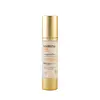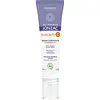What's inside
What's inside
 Key Ingredients
Key Ingredients

 Benefits
Benefits

 Concerns
Concerns

 Ingredients Side-by-side
Ingredients Side-by-side

Water
Skin ConditioningCyclopentasiloxane
EmollientPropanediol
SolventPentylene Glycol
Skin ConditioningIsostearyl Isostearate
EmollientButylene Glycol Dicaprylate/Dicaprate
EmollientPropylene Glycol
HumectantPEG-6 Stearate
EmulsifyingCetearyl Alcohol
EmollientCaprylic/Capric Triglyceride
MaskingCyclohexasiloxane
EmollientPEG-100 Stearate
Glyceryl Stearate
EmollientGlyceryl Behenate
EmollientResveratrol Dimethyl Ether
AntioxidantQuercetin
AntioxidantPalmitoyl Tripeptide-5
Skin ConditioningMorus Alba Root Extract
BleachingGlycyrrhiza Glabra Root Extract
BleachingGinkgo Biloba Leaf Extract
Skin ConditioningCitrus Aurantium Dulcis Fruit Extract
Masking3-O-Ethyl Ascorbic Acid
Skin ConditioningTocopheryl Acetate
AntioxidantPEG-32 Stearate
EmulsifyingGlycol Stearate
EmollientTriethanolamine
BufferingPolymethyl Methacrylate
Lecithin
EmollientAcrylates/C10-30 Alkyl Acrylate Crosspolymer
Emulsion StabilisingMica
Cosmetic ColorantAlcohol
AntimicrobialTitanium Dioxide
Cosmetic ColorantDimethiconol
EmollientBHT
AntioxidantPolysorbate 20
EmulsifyingTricaprylin
MaskingDisodium EDTA
Sodium Chloride
MaskingGlycerin
HumectantSodium Cholate
Skin ConditioningHydroxypropyl Cyclodextrin
MaskingSodium Hydroxide
BufferingPhenoxyethanol
PreservativeEthylhexylglycerin
Skin ConditioningPotassium Sorbate
PreservativeParfum
MaskingLimonene
PerfumingLinalool
PerfumingCitral
PerfumingCI 15985
Cosmetic ColorantWater, Cyclopentasiloxane, Propanediol, Pentylene Glycol, Isostearyl Isostearate, Butylene Glycol Dicaprylate/Dicaprate, Propylene Glycol, PEG-6 Stearate, Cetearyl Alcohol, Caprylic/Capric Triglyceride, Cyclohexasiloxane, PEG-100 Stearate, Glyceryl Stearate, Glyceryl Behenate, Resveratrol Dimethyl Ether, Quercetin, Palmitoyl Tripeptide-5, Morus Alba Root Extract, Glycyrrhiza Glabra Root Extract, Ginkgo Biloba Leaf Extract, Citrus Aurantium Dulcis Fruit Extract, 3-O-Ethyl Ascorbic Acid, Tocopheryl Acetate, PEG-32 Stearate, Glycol Stearate, Triethanolamine, Polymethyl Methacrylate, Lecithin, Acrylates/C10-30 Alkyl Acrylate Crosspolymer, Mica, Alcohol, Titanium Dioxide, Dimethiconol, BHT, Polysorbate 20, Tricaprylin, Disodium EDTA, Sodium Chloride, Glycerin, Sodium Cholate, Hydroxypropyl Cyclodextrin, Sodium Hydroxide, Phenoxyethanol, Ethylhexylglycerin, Potassium Sorbate, Parfum, Limonene, Linalool, Citral, CI 15985
Water
Skin ConditioningMalva Sylvestris Extract
AstringentCaprylic/Capric Triglyceride
MaskingGlycerin
HumectantAscorbyl Glucoside
AntioxidantPolyglyceryl-6 Stearate
EmollientLactobacillus Ferment
Skin ConditioningOctyldodecanol
EmollientDicaprylyl Ether
EmollientArginine Ferulate
Skin ConditioningPentylene Glycol
Skin ConditioningLauroyl Lysine
Skin ConditioningCaprylyl Glycol
EmollientPhytic Acid
Levulinic Acid
PerfumingSodium Levulinate
Skin ConditioningParfum
MaskingCetearyl Alcohol
EmollientGlyceryl Stearate Se
EmulsifyingSodium Stearoyl Glutamate
CleansingPolyglyceryl-6 Behenate
Emulsion StabilisingBentonite
AbsorbentXanthan Gum
EmulsifyingSclerotium Gum
Emulsion StabilisingHydrolyzed Hyaluronic Acid
HumectantSodium Hydroxide
BufferingLactic Acid
BufferingSodium Benzoate
MaskingCI 77492
Cosmetic ColorantCI 77491
Cosmetic ColorantCI 77499
Cosmetic ColorantTocopherol
AntioxidantWater, Malva Sylvestris Extract, Caprylic/Capric Triglyceride, Glycerin, Ascorbyl Glucoside, Polyglyceryl-6 Stearate, Lactobacillus Ferment, Octyldodecanol, Dicaprylyl Ether, Arginine Ferulate, Pentylene Glycol, Lauroyl Lysine, Caprylyl Glycol, Phytic Acid, Levulinic Acid, Sodium Levulinate, Parfum, Cetearyl Alcohol, Glyceryl Stearate Se, Sodium Stearoyl Glutamate, Polyglyceryl-6 Behenate, Bentonite, Xanthan Gum, Sclerotium Gum, Hydrolyzed Hyaluronic Acid, Sodium Hydroxide, Lactic Acid, Sodium Benzoate, CI 77492, CI 77491, CI 77499, Tocopherol
 Reviews
Reviews

Ingredients Explained
These ingredients are found in both products.
Ingredients higher up in an ingredient list are typically present in a larger amount.
This ingredient is an emollient, solvent, and texture enhancer. It is considered a skin-softener by helping the skin prevent moisture loss.
It helps thicken a product's formula and makes it easier to spread by dissolving clumping compounds.
Caprylic Triglyceride is made by combining glycerin with coconut oil, forming a clear liquid.
While there is an assumption Caprylic Triglyceride can clog pores due to it being derived from coconut oil, there is no research supporting this.
Learn more about Caprylic/Capric TriglycerideCetearyl alcohol is a mixture of two fatty alcohols: cetyl alcohol and stearyl alcohol. It is mainly used as an emulsifier. Emulsifiers help prevent the separation of oils and products. Due to its composition, it can also be used to thicken a product or help create foam.
Cetearyl alcohol is an emollient. Emollients help soothe and hydrate the skin by trapping moisture.
Studies show Cetearyl alcohol is non-toxic and non-irritating. The FDA allows products labeled "alcohol-free" to have fatty alcohols.
This ingredient is usually derived from plant oils such as palm, vegetable, or coconut oils. There is debate on whether this ingredient will cause acne.
Due to the fatty acid base, this ingredient may not be Malassezia folliculitis safe.
Learn more about Cetearyl AlcoholGlycerin is already naturally found in your skin. It helps moisturize and protect your skin.
A study from 2016 found glycerin to be more effective as a humectant than AHAs and hyaluronic acid.
As a humectant, it helps the skin stay hydrated by pulling moisture to your skin. The low molecular weight of glycerin allows it to pull moisture into the deeper layers of your skin.
Hydrated skin improves your skin barrier; Your skin barrier helps protect against irritants and bacteria.
Glycerin has also been found to have antimicrobial and antiviral properties. Due to these properties, glycerin is often used in wound and burn treatments.
In cosmetics, glycerin is usually derived from plants such as soybean or palm. However, it can also be sourced from animals, such as tallow or animal fat.
This ingredient is organic, colorless, odorless, and non-toxic.
Glycerin is the name for this ingredient in American English. British English uses Glycerol/Glycerine.
Learn more about GlycerinParfum is a catch-all term for an ingredient or more that is used to give a scent to products.
Also called "fragrance", this ingredient can be a blend of hundreds of chemicals or plant oils. This means every product with "fragrance" or "parfum" in the ingredients list is a different mixture.
For instance, Habanolide is a proprietary trade name for a specific aroma chemical. When used as a fragrance ingredient in cosmetics, most aroma chemicals fall under the broad labeling category of “FRAGRANCE” or “PARFUM” according to EU and US regulations.
The term 'parfum' or 'fragrance' is not regulated in many countries. In many cases, it is up to the brand to define this term.
For instance, many brands choose to label themselves as "fragrance-free" because they are not using synthetic fragrances. However, their products may still contain ingredients such as essential oils that are considered a fragrance by INCI standards.
One example is Calendula flower extract. Calendula is an essential oil that still imparts a scent or 'fragrance'.
Depending on the blend, the ingredients in the mixture can cause allergies and sensitivities on the skin. Some ingredients that are known EU allergens include linalool and citronellol.
Parfum can also be used to mask or cover an unpleasant scent.
The bottom line is: not all fragrances/parfum/ingredients are created equally. If you are worried about fragrances, we recommend taking a closer look at an ingredient. And of course, we always recommend speaking with a professional.
Learn more about ParfumPentylene glycol is typically used within a product to thicken it. It also adds a smooth, soft, and moisturizing feel to the product. It is naturally found in plants such as sugar beets.
The hydrophilic trait of Pentylene Glycol makes it a humectant. As a humectant, Pentylene Glycol helps draw moisture from the air to your skin. This can help keep your skin hydrated.
This property also makes Pentylene Glycol a great texture enhancer. It can also help thicken or stabilize a product.
Pentylene Glycol also acts as a mild preservative and helps to keep a product microbe-free.
Some people may experience mild eye and skin irritation from Pentylene Glycol. We always recommend speaking with a professional about using this ingredient in your routine.
Pentylene Glycol has a low molecular weight and is part of the 1,2-glycol family.
Learn more about Pentylene GlycolSodium Hydroxide is also known as lye or caustic soda. It is used to adjust the pH of products; many ingredients require a specific pH to be effective.
In small amounts, sodium hydroxide is considered safe to use. However, large amounts may cause chemical burns due to its high alkaline.
Your skin has a natural pH and acid mantle. This acid mantle helps prevent harmful bacteria from breaking through. The acid mantle also helps keep your skin hydrated.
"Alkaline" refers to a high pH level. A low pH level would be considered acidic.
Learn more about Sodium HydroxideWater. It's the most common cosmetic ingredient of all. You'll usually see it at the top of ingredient lists, meaning that it makes up the largest part of the product.
So why is it so popular? Water most often acts as a solvent - this means that it helps dissolve other ingredients into the formulation.
You'll also recognize water as that liquid we all need to stay alive. If you see this, drink a glass of water. Stay hydrated!
Learn more about Water